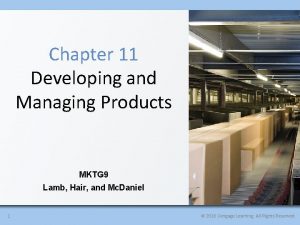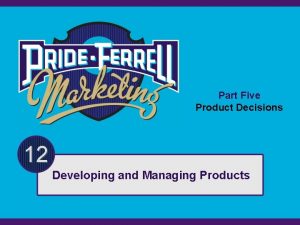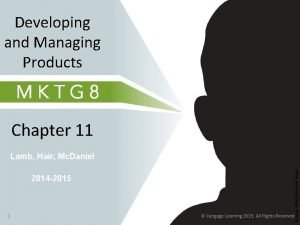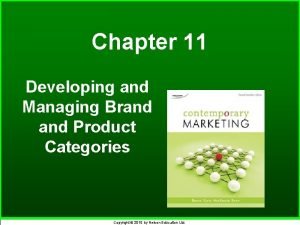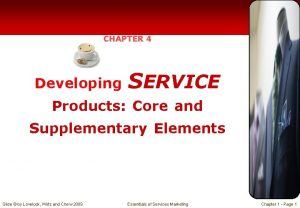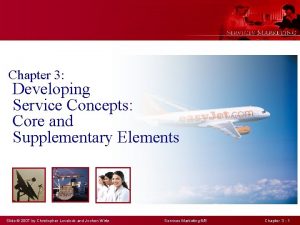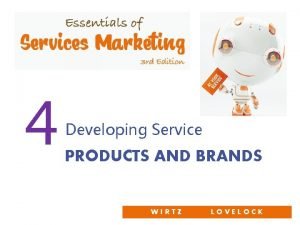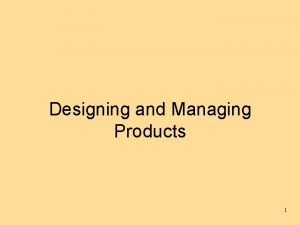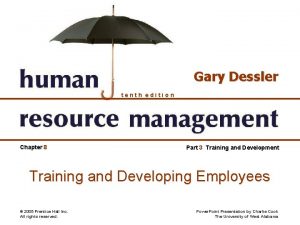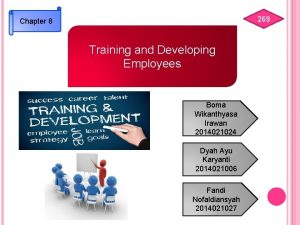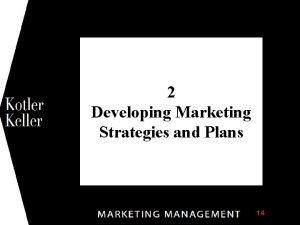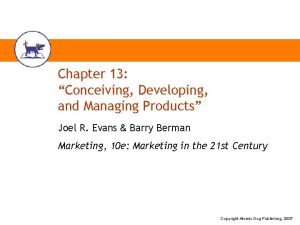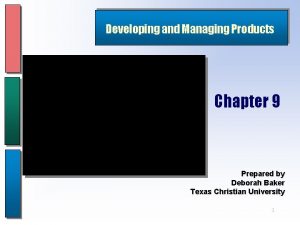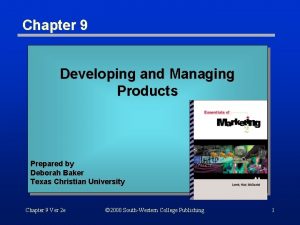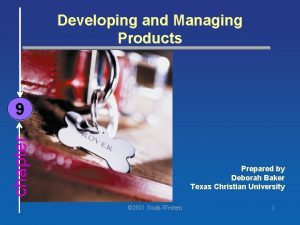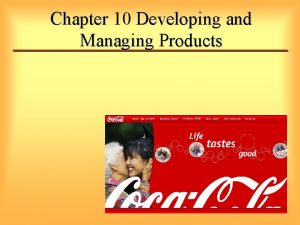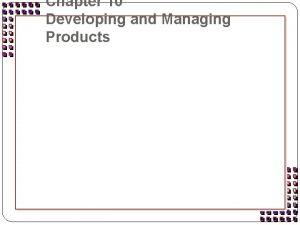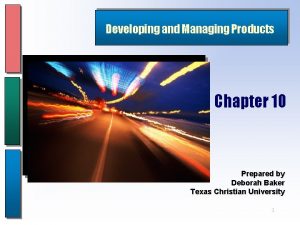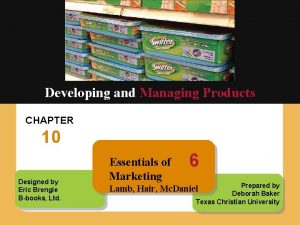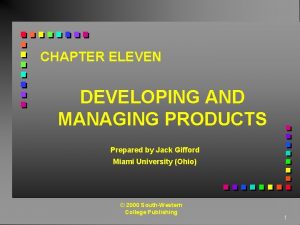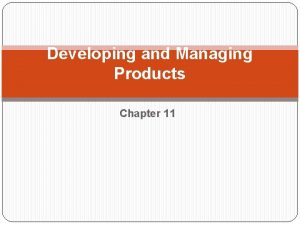Introduction to Chapter 11 Developing and Managing Products




















- Slides: 20

Introduction to Chapter 11: Developing and Managing Products Designed & Prepared by Laura Rush B-books, Ltd. Copyright Cengage Learning 2013 All Rights Reserved 1

Learning Outcomes LO 1 Explain the importance of developing new products and describe the six categories of new products LO 2 Explain the steps in the new-product development process LO 3 Explain why some products succeed and others fail LO 4 Discuss global issues in new-product development LO 5 Explain the diffusion process through which new products are adopted LO 6 Explain the concept of product life cycles 2

New Product Advantages Being first on the market has numerous advantages: • • • Increased sales through longer sales life Increased margins Increased product loyalty More resale opportunities Greater market responsiveness A sustained leadership position Copyright Cengage Learning 2013 All Rights Reserved 3

Categories of New Products New-to-the-World New Product Lines Product Line Additions Improvements or Revisions Repositioned Products Lower-Priced Products Copyright Cengage Learning 2013 All Rights Reserved 4

The New-Product Development Process New Product Success Factors Long-term commitment Company-specific approach Capitalize on experience Establish an environment Copyright Cengage Learning 2013 All Rights Reserved 5

New-Product Development Process 1. New-Product Strategy 2. Idea Generation 3. Idea Screening 4. Business Analysis 5. Development 6. Test Marketing 7. Commercialization 8. New Product Copyright Cengage Learning 2013 All Rights Reserved 6

Why New Products Fail • No discernible benefits • Poor match between features and customer desires • Overestimation of market size • Incorrect positioning • Price too high or too low • Inadequate distribution • Poor promotion • Inferior product Copyright Cengage Learning 2013 All Rights Reserved 7

Success Factors in Successful New Products Match between product and market needs Different from substitute products Benefit to large number of people Copyright Cengage Learning 2013 All Rights Reserved 8

Success Factors Listening to customers Strong leadership Producing the best product Commitment to newproduct development Vision of future market Project-based team approach Getting every aspect right Willingness to fail occasionally Copyright Cengage Learning 2013 All Rights Reserved 9

Global Issues § Develop product for potential worldwide distribution § Build in unique market requirements § Design products to meet regulations and key market requirements Copyright Cengage Learning 2013 All Rights Reserved 10

Diffusion The process by which the adoption of an innovation spreads. Copyright Cengage Learning 2013 All Rights Reserved 11

Categories of Adopters Innovators Early Adopters Early Majority Late Majority Laggards Copyright Cengage Learning 2013 All Rights Reserved 12

Product Characteristics and the Rate of Adoption Complexity Compatibility Relative Advantage Observability Trialability Copyright Cengage Learning 2013 All Rights Reserved 13

Marketing Implications of the Adoption Process Word of Mouth Communication Aids the Diffusion Process Direct from Marketer Copyright Cengage Learning 2013 All Rights Reserved 14

Product Life Cycle A biological metaphor that traces the stages of a product’s acceptance, from its introduction (birth) to its decline (death). Copyright Cengage Learning 2013 All Rights Reserved 15

U. S. Sales of Widgets Copyright Cengage Learning 2013 All Rights Reserved 16

Introductory Stage • High failure rates • Little competition • Frequent product modification • Limited distribution • High marketing and production costs • Negative profits with slow sales increases • Promotion focuses on awareness and information • Communication challenge is to stimulate primary demand Copyright Cengage Learning 2013 All Rights Reserved 17

Growth Stage • Increasing rate of sales • Entrance of competitors • Market consolidation • Initial healthy profits • Aggressive advertising of the differences between brands • Wider distribution Copyright Cengage Learning 2013 All Rights Reserved 18

Maturity Stage • Sales increase at a decreasing rate • Saturated markets • Annual models appear • Lengthened product lines • Service and repair assume important roles • Heavy promotions to consumers and dealers • Marginal competitors drop out • Niche marketers emerge Copyright Cengage Learning 2013 All Rights Reserved 19

Decline Stage • Long-run drop in sales • Large inventories of unsold items • Elimination of all nonessential marketing expenses • “Organized abandonment” Copyright Cengage Learning 2013 All Rights Reserved 20
 Chapter 11 developing and managing products
Chapter 11 developing and managing products Developing and managing products
Developing and managing products Developing and managing products
Developing and managing products Developing and managing products
Developing and managing products Brand &+product type l1
Brand &+product type l1 Flower of service
Flower of service Developing service products core and supplementary elements
Developing service products core and supplementary elements Flower of service model
Flower of service model Developing new products and services
Developing new products and services Managing products and brands
Managing products and brands Innovative and functional products
Innovative and functional products Pepsi 4ps marketing mix
Pepsi 4ps marketing mix Chapter 8 training and developing employees
Chapter 8 training and developing employees The marketing plan the central instrument
The marketing plan the central instrument Chapter 8 training and development
Chapter 8 training and development Ilumination
Ilumination Chapter 8 managing stress and anxiety
Chapter 8 managing stress and anxiety Leasiest
Leasiest Chapter 6 managing weight and body composition
Chapter 6 managing weight and body composition Chapter 11 managing weight and eating behaviors
Chapter 11 managing weight and eating behaviors Chapter 11 lesson 1 maintaining a healthy weight
Chapter 11 lesson 1 maintaining a healthy weight
